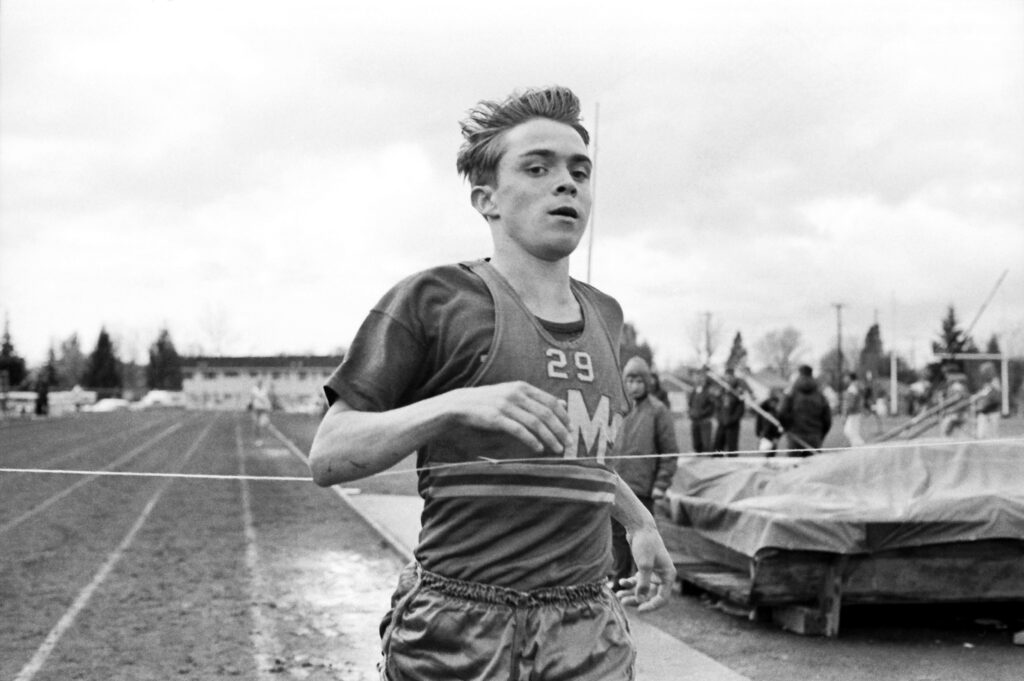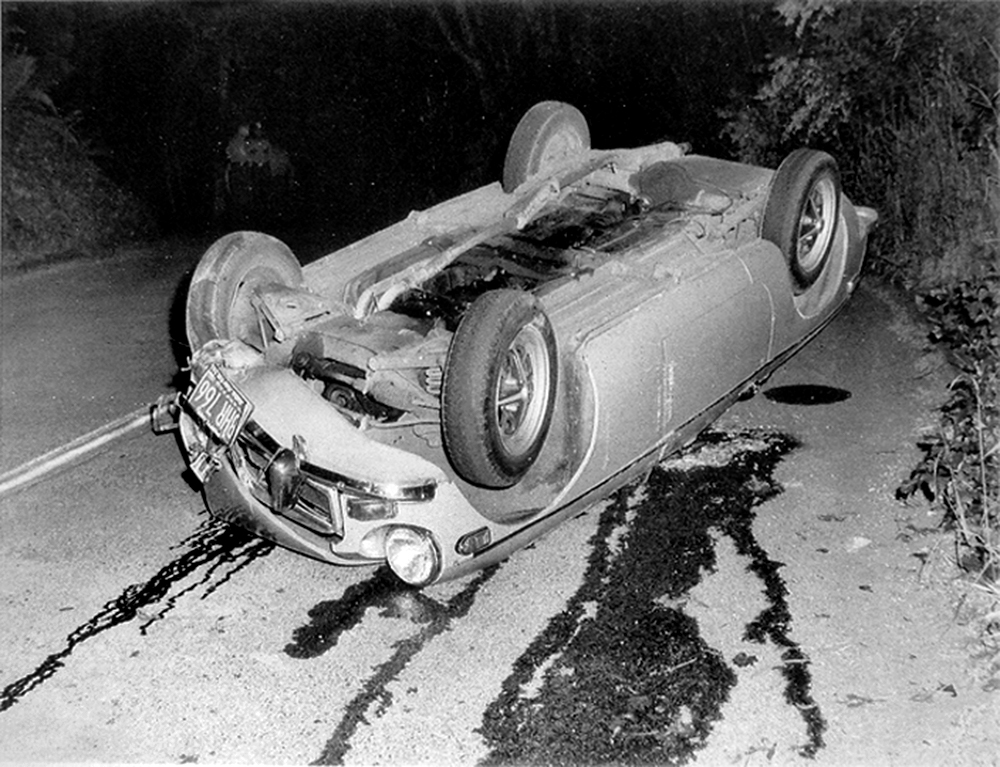Pre
40 years after the Oregon track legend’s death, the mysteries concerning his fatal car crash linger

Fierce. Fearless. Fighter. Grit. Gumption. Guts. Hero. History. Courage. Icon. Driven. Incredible. Unforgettable. Beautiful.
Legend.
Who knows what Steve Prefontaine would have thought about something as futuristic as Facebook. When I recently posted on the social media site “Tell me, in just one word, what you think of when you hear the name ‘Pre,'” with an old Register-Guard photograph of him running at Hayward Field in his final race just hours before he was killed in a car crash 40 years ago this month, those were some of the responses I got.
Four decades later, we remember. We cannot forget him, or the way he ran, or how it affected us.
Why?
“He was so open and inviting,” says Eugene’s Kenny Moore, the author, former Sports Illustrated writer, University of Oregon track man and fellow Olympian of Prefontaine’s at the 1972 Summer Games in Munich. “He had the crowd. There was nothing like him.”
It was in Munich, his mother Elfriede Prefontaine’s native country, where 21-year-old Steve Prefontaine wowed everyone by doing what he always did, pushing the pace in the 5,000 meters and moving out front in a thrilling effort to win the gold medal against the world’s best distance runners. Alas, he finished fourth, just missing the bronze.
“We all feel something when the crowd goes crazy, but he gave more,” Moore says. “It’s a matter of degrees. No one gave as much as he did.”
Prefontaine’s sudden and tragic death, on May 30, 1975, was a story that shocked not only Eugene and the rest of Oregon, but much of the nation.
The fiery-eyed prodigy from Coos Bay, who would go on to shatter records at the UO from 1969 to 1973, was only 24 and the holder of seven American records, from 2,000 meters to 10,000 meters, when he died. He was certainly the most popular track and field athlete in the nation at the time, if not the world.
Years later, Prefontaine’s life story was made into two feature films: 1997’s “Prefontaine” and 1998’s “Without Limits.”
And the annual track meet that bears his name, the Prefontaine Classic, has grown into one of the world’s most popular.
The 41st annual edition falls 40 years to the day he died, taking place Friday and Saturday at Hayward Field.
Prefontaine’s younger sister, Linda Prefontaine, 61, of Eugene, will be there, as always.
“People ask how you feel after 40 years, and how you deal with it?” she says. “It’s like losing an appendage and then learning how to live without it. You make adjustments to living without that person, and your life is never the same. All we can do at this point is honor him.”
“Dead at the scene”
Steve Prefontaine’s death, on a tight curve of narrow Skyline Boulevard near Eugene’s Hendricks Park, is also a cautionary tale.
Which brings us back to another one-word summation someone wrote on that Facebook posting: Beer.
According to the police report, a blood sample taken in those early morning hours after the 12:39 a.m. crash put Prefontaine’s blood-alcohol level at 0.16 percent, which today would be twice the legal limit of presumed impairment of 0.08 percent. In 1975, the presumed level of impairment was 0.10.
Yet what caused him to drive into what for four decades since has been known as his shrine, Pre’s Rock, is still a mystery to some.
Was he simply intoxicated?
Did a dog, a deer or a raccoon run in front of his gold 1973 MGB convertible sports car?
Was another vehicle involved?
This is what the report, still on file at the Eugene Police Department, says about Case No. 75-9498: “The victim was alone, driving his vehicle eastbound on Skyline Drive and crossed the centerline to the left side of the roadway. The vehicle went over the curb and hit a solid rock embankment and flipped over onto its top in the roadway. The victim was pinned partially under the overturned vehicle. The victim was dead at the scene.”
The first responding officer was Sgt. Richard Loveall. This is what he told The Register-Guard in 1985, when the newspaper did a 10th anniversary story on Pre’s death: “He died because he consumed too much alcohol and drove. That was the truth of the matter.”
Loveall, who died of a heart attack in Creswell at age 65 in 2007, also told the Los Angeles Times in 1985 that what remained with him most, 10 years after the crash, was the pungent smell of alcohol, although no containers of any kind were found in the car or at the scene.
“There are always those who will hold out for that 1 percent chance that something else happened that night,” Loveall told Register-Guard sports reporter Cathy Henkel in ’85. “For those people who worshipped him or loved him, I say fine, let them hold onto that 1 percent. But to young people, I would hope they would learn what that accident says about drinking and driving.”
“His prodigious honesty”
Those closest to him, while acknowledging that Prefontaine certainly was drinking that night, have always refused to believe that it was intoxicated driving that caused him to lose control of his car and slam into that rock wall.
“No, I think that was just another story that somebody made up,” says Neta Prefontaine, 73, of Eugene, Pre’s other sister. “I don’t think (Frank) Shorter would have driven with him if he was drunk. I think he was tired, because he didn’t sleep the night before.”
Shorter, a close friend of Prefontaine and the 1972 Olympic marathon winner in Munich, had come to Eugene to race him in the 5,000 meters at an NCAA preparation meet at Hayward Field on May 29, 1975.
The two were at an after party at former UO runner and early Nike employee Geoff Hollister’s south Eugene home, along with Moore, Prefontaine’s parents, his girlfriend at the time, Nancy Alleman, several Finnish athletes who were in town to compete, and many others.
Prefontaine, Shorter and Alleman left the party about 12:15 a.m., according to a May 30, 1975, Register-Guard story. Prefontaine took Alleman to her car parked by the UO ticket office, near McArthur Court, then took Shorter to Moore’s home on Prospect Drive, where Shorter was staying that weekend.
The accident scene was only a few of blocks from there.
“Anytime you party with New Zealanders or Finns, there is drinking,” Shorter told Register-Guard sports reporter Jerry Uhrhammer later that day. Shorter declined to say how much Prefontaine had to drink but said it was “enough to affect his driving,”
But Shorter added that he was not afraid to drive with Prefontaine.
Said Moore, now 71, just a few days ago: “Frank had absolutely no doubt that (Prefontaine) had perfect control.” Shorter was a “dear friend” of Prefontaine’s, Moore says. “He would have driven if he thought he was in any danger.”
Moore was at the track meet that night working on a profile of Prefontaine for Sports Illustrated. He would end up writing a very different story that appeared in the June 9, 1975, issue of the magazine.
In it, he described how, after being informed of Prefontaine’s death upon waking that morning, he and Shorter went down to the scene and saw “the broken glass and twisted metal strewn among the poison oak …
“We saw the accident report, which said he was dead at the scene, his chest and stomach crushed under the weight of the overturned car,” Moore wrote. “His blood-alcohol content had been found to be .16 percent, a level presumed to significantly impair driving. We always knew that the important thing about his life, that which let him perform as he did, was his prodigious honesty. Because he had never been hypocritical about his use of alcohol, the manner of his death could not diminish that honesty.
Perhaps the most intriguing part of what happened that night comes from the descriptions of those who first saw the scene.
The other MGB
Bill Alvarado, 38 at the time, lived in the home closest to the crash site, at 2415 Skyline Blvd.
He and his wife, Karen, attended the track meet that night and were getting ready for bed about 12:30 a.m. when they heard a car traveling rapidly on Skyline. Alvarado, who died in Oakridge at age 70 in 2006, told police he “heard the squeal of tires, a loud thump, and then silence.”
He dressed quickly, went outside and saw “a light-colored sports car hard top coming up the street towards his residence … at a high rate of speed,” according to the police report.
Alvarado told police he tried to stop the car by “waving his arms and hollering,” according to the report written by officer Rex Ballenger, who arrived on scene about 1 a.m., “but the vehicle drove on past him.”
Alvarado then got into his car and tried to follow the vehicle, which he told reporters was another MGB sports car, similar to Prefontaine’s. But he couldn’t find it. Alvarado then made a complete circle on Skyline, came back around on Birch Lane, took a left on Skyline and came upon Prefontaine’s overturned car.
“I hate to say it, but I couldn’t do anything,” Alvarado told The Register-Guard later that day. “I couldn’t lift the car. My back still aches from trying. I had no idea who was under the car. I knew Pre’s car, but I was hoping it wasn’t him.”
Sgt. Loveall arrived, and Alvarado told him about the other vehicle driving quickly past him. Loveall contacted another officer and advised him to search the area.
That officer found that car parked nearby on Kona Street. Ballenger and that officer then interviewed Karl Bylund, 20, the driver of the car, according to the police report.

Bylund told police that he came upon Prefontaine’s vehicle, which was upside-down in the right lane, on his way home. He said he got out, “observed that the driver had been injured,” then drove home to tell his father, Dr. Richard Bylund. His father told him to call the police, which the report says he did.
Police noted that there was no apparent damage to Bylund’s car.
Five days later, on June 4, 1975, Ballenger interviewed Karl Bylund again, according to the police report. Bylund told Ballenger he had seen someone waving him down but “didn’t stop because he only lived a short distance away and he wanted to advise his father right away.”
Ballenger than asked Bylund if he would voluntarily take a polygraph (lie-detector) test, and he did so on June 6, 1975.
“The test indicated that Bylund was not involved in the accident and that previous statements made to me by Bylund were correct,” Ballenger wrote in his report.
Henkel’s 1985 Register-Guard story said Neta Prefontaine was allowed to watch Bylund take the test through a one-way mirror, but “no one was allowed to hear or read any of the questions or answers.”
Forty years later, Neta Prefontaine says she was not the only one allowed to view the test, rather the entire family – including parents Ray and Elfriede Prefontaine, both now deceased – was allowed to watch.
“We were all watching it and were curious to see how he responded,” Neta Prefontaine says. “But he was very calm.”
Bylund, now a 60-year-old engineer in Seattle, refused to talk to reporters at the time, and also 10 years later, according to the 1985 story by Henkel, who later became sports editor of The Seattle Times. And he did not return a phone call left for him a few days ago.
“He was innocent of any wrongdoing,” his father told Henkel in 1985. “It was happenstance. It was a very bad experience for him, and he was pretty well put through the wringer. He doesn’t want to talk because he was treated rather roughly by reporters.”
“A real-hard left”
Ballenger, the 28-year-old Eugene police officer who wrote the report and investigated the crash, is now 68 and retired and still living in Eugene. He spent just five years with the department, from 1971 to 1976, and then began a real estate career.
On Friday, he returned a phone call while taking a break from his job helping to officiate the state high school track meets that concluded on Saturday at Hayward Field.
“He was a drunk driver … who wasn’t wearing his seat belt,” says Ballenger, adding that he drove that stretch of Skyline in his police car several times during the week following the crash, testing it at different speeds.
“You couldn’t make that corner at 40 mph,” Ballenger says. “Given (Prefontaine’s) blood-alcohol level, it would have been easy to miss that corner.”
The night of the crash, Loveall told The Register-Guard there was no evidence that Prefontaine was speeding on a street with a 25 mph limit.
Ballenger wrote in his report that there were no skid marks but “scuff marks leading to the point of impact” that appeared to have been left by “a forward rotating tire which was sliding sideways.”
One theory was that Prefontaine took his eyes off the road while inserting a cassette tape, because the police said they found a John Denver tape, “Back Home Again,” lying on the road next to Pre’s body.
But Linda Prefontaine said at the time, as she says now, that she found the tape in her brother’s van two weeks after the crash, so it must have just been the cassette tape box that was found on the street.
Four decades later, she and others refuse to accept what the police say, that her brother died because he was driving while intoxicated.
“We questioned what happened that night, because we don’t believe he was drunk,” Linda Prefontaine says.
As for her brother having a .16 blood-alcohol content, Linda Prefontaine says: “That’s what they said. But don’t we know that police do corrupt things? We know that that blood sample disappeared. The bottom line is, no one knows for sure.”
Dr. Ed Wilson, Lane County’s medical examiner in 1975, and also 10 years later, when Henkel interviewed him, said it was not standard procedure for the police to have a mortician draw blood for a sampling, as was done at 4:15 a.m. on May 30, 1975, at England’s funeral home in Eugene, according to the police report.
The autopsy performed on May 31 concluded that Prefontaine had died of “traumatic asphyxiation” because of the pressure of the overturned car on his chest and stomach.
In 1985, Wilson told Henkel that it was during the autopsy that he learned a mortician had drawn the blood the previous day.
“The medical examiner is the one who does that,” Wilson said. “All I can say is this was done in an unusual manner, and I don’t remember ever having it happen that way before or since. I was very angry about it.”
Depending on how and when a mortician drew blood, the test can be off by as much as 20 percent either way because the blood stops mixing after death, Wilson told Henkel. But 20 percent still would have placed Pre above the legal limit of presumed intoxication.
Moore believes that someone or something must have made Pre swerve.
“He was definitely evading something, I think,” Moore says.
Moore lived in his home on Prospect Drive until 1985, he says, and for the next decade after the crash, every time he took that curve on Skyline, he’d try to imagine what happened. Sometimes he would take the wheel of his car in his hands and begin to crank it a hard left, just to get the feel.
“It took a real-hard left turn to make that car go over,” Moore says.
First place award for best feature story in the 2016 Oregon Newspaper Publishers Association “Better Newspaper Contest.”

Mark Baker has been a journalist for the past 25 years. He’s currently the sports editor at The Jackson Hole News & Guide in Jackson, Wyo.
